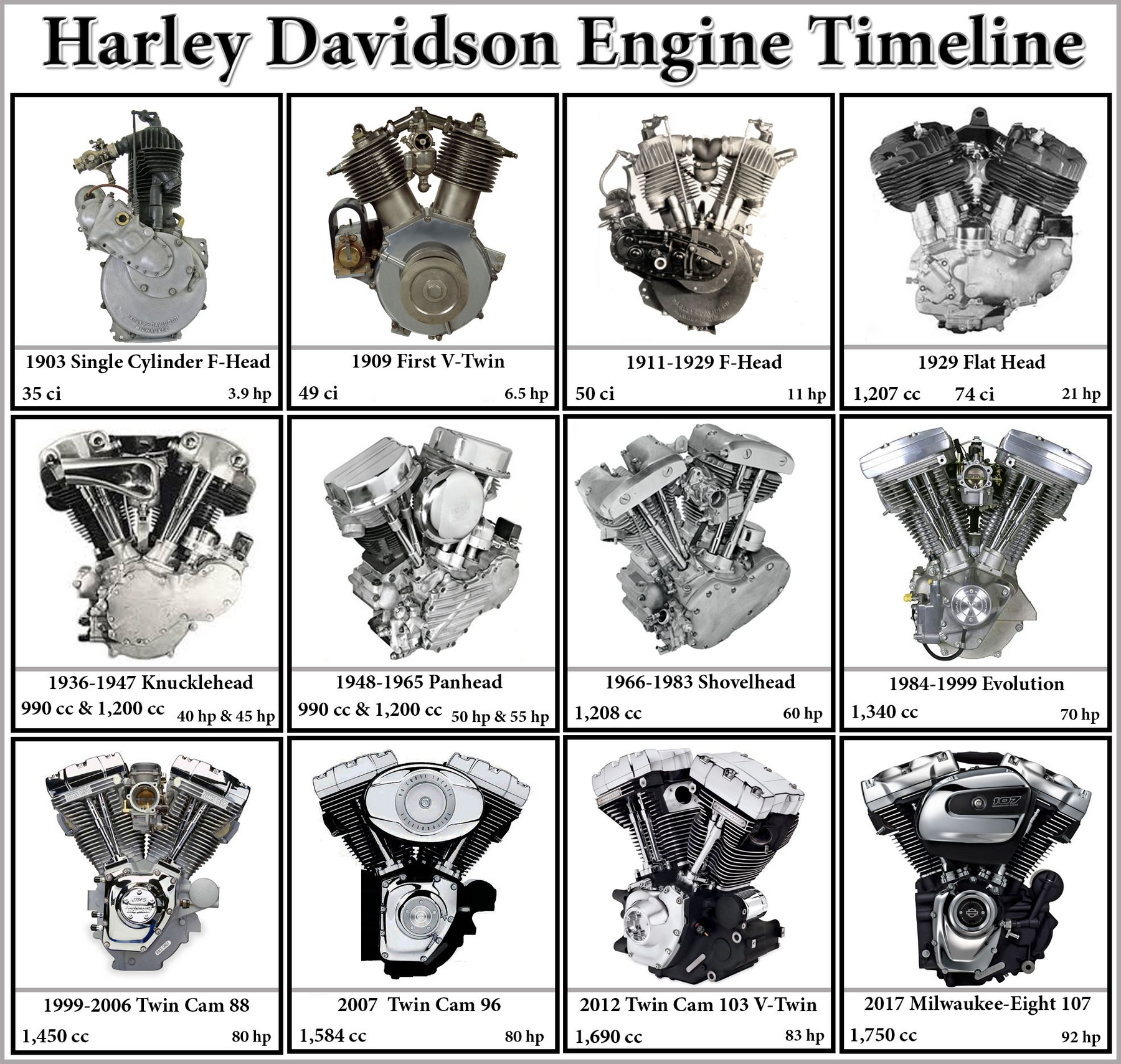
Harley Davidson Motorcycle Engine History | EngineDIY
For fans of power machinery, 1903 is undoubtedly memorable, the year the Wright brothers flew into the sky for the first time, Ford was also established in this year, and for American locomotive fanatics, the most important is of course the year Harley-Davidson was born, from then on to lead the freedom-loving riders, launched a long march of 120 years. Today let's review the history of Harley-Davidson engine power development.
1903 Single Cylinder F-head
Harley Davidson was born in Milwaukee near Lake Michigan, Wisconsin, USA in 1903. The single-cylinder motor was the foundation of the Harley-Davidson empire.
The first Harley-Davidson motorcycle (on display in the main lobby on Juneau Avenue) was a single-cylinder motorcycle with atmospheric valve control and belt drive. The company produced only single-cylinder motorcycles until 1909 when the HD V-twin was launched on the market.

1909 First V-twin
Harley Davidson developed the first V-Twin (V-type twin-cylinder) engine in 1909, and named it F-Head. The single-cylinder engine that was widely used at that time, the F-Head had a displacement of about 800cc. However, due to some insurmountable defects of this engine, only 27 were produced in total, and it was withdrawn from the market in the second year. Although this engine did not gain a foothold in the market in the end, the "V" shape it created was of great significance and became the "template" for Harley's engine styling in the future.

1911-1929 F-Head

The really well-known F-Head is actually an improved version in 1911 (equipped with the 7D model). Therefore, after the V-Twin gradually showed its prominence, the original F-Head was recognized as the first V-Twin engine of Harley Davidson.

The biggest feature of F-Head is the drive form and position of the intake and exhaust valves. The intake valve of F-Head is designed on the top of the cylinder, and the valve is opened and closed by the power of the crankshaft through the tappet, while the exhaust valve is set on the side of the piston, and the power of the crankshaft is also transmitted by the tappet. And this design also became the cornerstone of Harley-Davidson's later Side Valve (side valve), which further inspired the V-Twin engine to move towards the OHV (over head valve) structure.
1929 Flat Head
In 1929, Harley Davidson successfully developed a V-Twin engine named "Flathead". Flathead is the first mass-produced engine designed by Harley Davidson with side valve.

The so-called side valve (also known as side valve engine or L-head engine) means that the position of the intake and exhaust is lower than the combustion chamber, and it is arranged side by side on the side of the cylinder, so it is called side valve. It is called "Flathead" because the intake and exhaust are installed on the side of the cylinder, resulting in a flat cylinder head. Flathead is actually the valve form used in automobiles at the earliest. It has the advantages of simplicity, cheapness and stable structure. Until now, there are still many machines that need these characteristics, such as agricultural machinery and lawn mowers. The Flathead was subsequently developed in many different versions and was used until 1972, making it one of the longest-lived engines. The first Flathead with a displacement of about 750cc was mounted on the classic Model D.
1936-1947 Knucklehead
In 1936, Harley Davidson made a major change in engine design, that is, the first V-Twin engine Knucklehead designed in the form of OHV came out.
Because the OHV design has greatly improved the valve efficiency, compared with the previous Flathead, Knucklehead's performance has also reached a new level. Knucklehead has powerful torque at low speeds, and can change the vibration rhythm and exhaust sound by adjusting the angle of the "V" shape. These technologies and features have been used to this day. In the early days, the displacement of Knucklehead was set at 1000cc, and later a version of 1200cc was developed. The displacement is larger than before, and Knucklehead has since been called Big Twin (compared to Flathead's Baby Twin). Knucklehead belongs to the OHV design. The position of the valve is changed from the side design of the Flathead to the top. In addition, the oil lubrication design is added around the valve, which also makes the shape of the top of the engine more complicated, resulting in an appearance that looks like a finger joint. This is also the origin of the Knucklehead name.
1948-1965 Panhead

The famous Harley-Davidson Panhead engine was in service for 17 years, from 1948 to 1965, affectionately known to those in the know as the Panhead. But even today, half a century after the end of production of this engine, many later car companies are still producing replicas of the famous twin! Because the Panhead is truly iconic and, according to many, the most beautiful Harley-Davidson engine ever built!
1966-1983 Shovelhead

The Shovelhead is the third version of Harley's OHV V-twin after the Knucklehead and Panhead. It is a modern, reliable and capable engine. Regarding the equipment, the head is really new for this engine, the cylinder heads are aluminum, the cylinders are cast iron, single camshaft with four cams, 2 valves per cylinder.
1984-1999 Evolution
Harley-Davidson gave this new engine the name Evolution, which symbolizes rebirth.

Compared with Shovelhead, the biggest difference in appearance of Evolution is that the cylinder head, upper and cylinder block are all made of aluminum alloy, which greatly improves the weight and heat dissipation effect. Inside the engine, in addition to the combination of cast iron cylinder and aluminum alloy cylinder, the valve also has higher precision due to the computerized production process. In addition, Harley-Davidson designed the aluminum alloy piston and added 12% silicon to it, which greatly reduces Frictional loss and thermal expansion during operation. In addition, the use of CV (negative pressure carburetor) is also an engine technology that began in this period.
1999-2006 Twin Cam 88
Twin Cam is the latest generation of Harley-Davidson engines.

In 1999, Harley-Davidson released the Twin Cam 88 engine that replaced the Evolution engine. The displacement was further expanded from the original 1340cc to 1450cc, and the output power was greatly improved. It was installed in the new Dyna and Touring car series. Each of the two cylinders of the Twin Cam engine has two independent camshafts (that is, the so-called double camshaft), so the design of the 1450cc displacement and two camshafts not only leaves a larger space on the side of the cylinder block Space, but also because of the enlarged cylinder bore in exchange for greater displacement and horsepower output. In addition, the cooling fins around the cylinder are further enlarged. Twin Cam88 has a cooling fin that is 50% larger than that of the Evolution, so the most important heat dissipation efficiency of the air-cooled engine has also been significantly improved.

2007 Twin Cam 96

In 2007, Harley-Davidson launched the Twin Cam 96 again, with the displacement increased to 1584cc.

2012 Twin Cam 103 V-twin
The Twin Cam 103 powertrain provides powerful passing power to all Harley-Davidson Touring models. On Touring models, the Twin Cam 103 is equipped with an oil cooler.

For 2012, all Harley-Davidson Softail models received a performance boost from the Twin Cam 103 engine. The Fat Boy and Fat Boy Lo feature new reduced handlebars for more comfortable ergonomics. The lower, narrower seat shape puts the Fat Boy rider in a new "bike" position. The Softail Deluxe and Heritage Softail Classic will be available with a new optional "tubeless" chrome-plated aluminum profile lace-up wheel option for easy tire changes and service.

2017 Milwaukee-Eight 107
For 2017, Harley-Davidson will launch the ninth generation of its venerable Big Twin, called the Milwaukee-Eight in honor of its birthplace and its number of valves—twice as many as found on the Twin Cam motor that’s been in the lineup since 1999. Harley-Davidson says the new engine platform provides faster throttle response, more torque, better sound, improved fuel economy and a smoother ride.

Finally, let's hear the sound of these engines together, and look forward to more engines.





Comments
Leave a comment